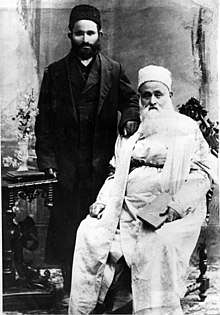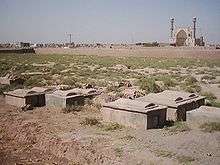History of the Jews in Afghanistan
The history of the Jews in Afghanistan goes back nearly 1,500 years,[1] but the community has been reduced greatly because of emigration.[1][2][3] Afghan Jewish communities now exist mostly in Israel, and the United States.
.svg.png)
| Part of a series of articles on |
| Religion in Afghanistan |
|---|
 |
| Majority |
| Sunni Islam |
| Minority |
|
| Historic/Extinct |
| Controversy |
|
|
The Jews had formed a community of leather and karakul merchants, landowners and money lenders alike. The large Jewish families mostly lived in the border city of Herat, while the families' patriarchs traveled back and forth on trading trips across the mountains of Afghanistan on whose rocks their prayers were carved in Hebrew and sometimes even Aramaic, moving between the routes on the ancient silk road.[4] Jews also settled in the capital city of Kabul.
As of 2019, only one known Jew, Zablon Simintov, remains residing in Afghanistan; he cares for a synagogue in Afghanistan's capital, Kabul.[5][6]
History

Records of a Jewish population in Afghanistan go back to the 7th century.[1] Afghan Jews claim ancestry to the Lost Israelite Tribes. Balkh was a main center for Jewish life in ancient Afghanistan. The city was said to have been the burial place of the Hebrew prophet Ezekiel, and the home of the prophet Jeremiah.[4] The city of Herat was important in the silk route, and other trading routes. In modern times, ruins still exist, and harbor a Jewish cemetery. Muhammad al-Idrisi (died 1166) wrote that Kabul had a Jewish quarter.[7] In the 18th century, Jews serving in the army of Nadir Shah settled in Kabul as his treasury guards.[7] In 2011, so-called Afghan Geniza, an 11th-century collection of manuscript fragments in Hebrew, Aramaic, Judeo-Arabic and Judeo-Persian was found in Taliban caves in Afghanistan. Some 29 pages from the collection were bought by the National Library of Israel in 2013.[8]
Soviet Refugee Crisis
By the early 1930s, some 60,000 refugees had fled from Soviet territory to Afghanistan.[1][2] In 1932, Muhammed Nadir Shah created a border treaty with the Soviet Union preventing asylum seekers from fleeing the border and into Afghanistan.[1][2] Later that same year, Afghanistan began deporting refugees back to Soviet Union or specified Chinese territories. Soviet Jews already in Afghanistan, who were attempting to flee further south, were detained in the capital city of Kabul, while any Soviet Jews apprehend at the border were immediately deported. Soviet Jews were accused of espionage and the intent to disseminate radical Bolshevist propaganda.
However, by 1933, non-refugee Afghani Jews, those who had lived there for decades if not centuries, were also targeted. All Jews who were citizens of Afghanistan were ordered to relocate to their birthplace, which was most often Herat or Kabul. This was an attempt by the government to further enforce the policy that Jews were not natives of the Northern provinces of Afghanistan. After Muhammad Nadir Shah was assassinated in 1933, his son continued the harsh fate for the Jews. By the end of 1933, nearly all of the Jews in northern cities had been expelled, and returned to Central Afghanistan.
In 1935, a delegate to the Zionist Congress declared that an estimated 40,000 Bukharan Jews had been killed or starved.[2]
In the summer of 1935, riots erupted in Herat, the Afghan city with the largest Jewish population, due to a dispute between two boys, one Jewish and one Muslim. The two boys got into a fight over unknown reasons, causing the Muslim boy to fall down the stairs. The Jewish boy, Aba Ben Simon, was blamed, and others began spreading rumors that he was trying to forcibly convert the other to Judaism.[2] This incident caused Herat's Shiite Muslims to take up arms against the Jews and pillage their shops, homes and beatings at the hands of the mobs. Jewish women, regardless of their marital status, were subjected to being kidnapped and raped, and sometimes were forcibly converted and married off to their attackers. Some Jews fled Herat, and were never allowed to return.
Some Jews tried to flee to British-controlled India. The British colonial government categorized them by passports: Iranian, Russian and Afghani. Those with Russian passports were once again accused of “Bolshevist ties” and denied entry. The British Raj tried to deport many Afghani and Russian Jews back to the Soviet Union under the guise of allegedly violating the “behavioral conduct” codes of British India (i.e., Peshawar Conspiracy Cases), when in fact the colonial government feared they would disseminate socialism among the populace of native Indian colonial subjects and lead them to revolt against oppressive colonial rule, adding to the then-growing Indian independence movement.[2]
The Jewish Life in Kabul and Herat continued to worsen. Many Jews fled illegally into India during the 1940s. Thousands of Jews fled to Palestine, (and eventually Israel after it was established in 1948). Some Jews also made it all the way to the United States, settling mainly in New York City's borough of Queens.[1]
Emigration
By 1948, over 5,000 Jews existed in Afghanistan, and after they were allowed to emigrate in 1951, most of them moved to Israel and the United States.[9] Afghanistan was the only Muslim country that allowed Jewish families to emigrate without revoking their citizenship first. Afghan Jews left the country en masse in the 1960s. Their resettlement in New York and Tel Aviv was motivated by a search for a better life. By 1969, some 300 remained, and most of these left after the Soviet invasion of 1979, leaving 10 Afghan Jews in 1996, most of them in Kabul.[2] More than 10,000 Jews of Afghan descent presently live in Israel. Over 200 families of Afghan Jews live in New York City in the USA.[3][9] Over 100 Jews of Afghan descent live in London.[1]
Current population
By the end of 2004, only two Jews were left in Afghanistan, Zablon Simintov and Isaac Levy. Simintov ran a store selling carpets and jewelry until 2001. They lived at separate ends of the dilapidated Kabul synagogue. They kept denouncing each other to the authorities, and both spent time in Taliban jails. The Taliban also confiscated the Torah. The contentious relationship between Simentov and Levy was dramatized in a play inspired by news reports of the two which appeared in international news media following the U.S.-led invasion of Afghanistan and the overthrow of the Taliban regime. The play, entitled "The Last Two Jews of Kabul," was written by playwright Josh Greenfeld and was staged in New York City in 2002.
In January 2005, Levy died of natural causes. Simentov is now the last remaining Jew in Afghanistan.[10] Simentov is trying to recover the confiscated Torah. Simentov, who does not speak Hebrew,[5] claims that the man who stole his Torah is now in U.S. custody in Guantanamo Bay. Simentov has a wife and two daughters who live in Israel, and he said he was considering joining them. However, when asked during a recent interview whether he would go to Israel, Simentov retorted, "Go to Israel? What business do I have there? Why should I leave?"[5]
There is also a disused Synagogue in Herat, in western Afghanistan, which contains most of its original characteristics although in a state of disrepair.[11]
See also
References
- author., Aharon, Sara Y. (2011). From Kabul to Queens : the Jews of Afghanistan and their move to the United States. American Sephardi Federation. ISBN 9780692010709. OCLC 760003208.
- Koplik, Sara (2003). "The demise of Afghanistan's Jewish community and the soviet refugee crisis (1932–1936)". Iranian Studies. 36 (3): 353–379. doi:10.1080/021086032000139131. ISSN 0021-0862.
- Arbabzadah, Nushin (28 February 2012). "The story of the Afghan Jews is one of remarkable tolerance". The Guardian. Retrieved 12 April 2017.
- "Balkh". www.jewishvirtuallibrary.org. Retrieved 2018-11-12.
- Motlagh, Jason (1 September 2007). "The last Jew in Afghanistan—Alone on Flower Street: He survived Soviets, Taliban – and outlasted even his despised peer". The San Francisco Chronicle. Retrieved 12 April 2017.
- Shaheed, Anisa (30 May 2018). "Afghanistan's Only Jew 'Worried' About The Country's Future". Tolo News. Retrieved 15 February 2019.
- Ben Zion Yehoshua-Raz, “Kabul”, in: Encyclopedia of Jews in the Islamic World, Executive Editor Norman A. Stillman. First published online: 2010
- "Ancient manuscripts indicate Jewish community once thrived in Afghanistan". CBS. 3 January 2013. Retrieved 12 April 2017.
- Krastev, Nikola (19 June 2007). "U.S.: Afghan Jews Keep Traditions Alive Far From Home". RFE/RL. New York. Retrieved 12 April 2017.
- Fletcher, Martin (14 June 2008). "The last Jew in Afghanistan". NBC News. Retrieved 12 April 2017.
- See Yu Aw Synagogue for references.
External links
- Zeva Oelbaum Photographs at the American Sephardi Federation, including photos taken of Jewish communities in Herat and Kabul in 1976.
- The "Other" in "Afghan" Identity: Medieval Jewish community of Afghanistan by Guy Matalon, PhD (article first published in Mardom Nama-e Bakhter in August 1997)
- Old pictures of the Jews of Afghanistan
- The Jewish History of Afghanistan: A long lost chapter of Jews in the Diaspora by Aaron Feigenbaum at Aish HaTorah's website


